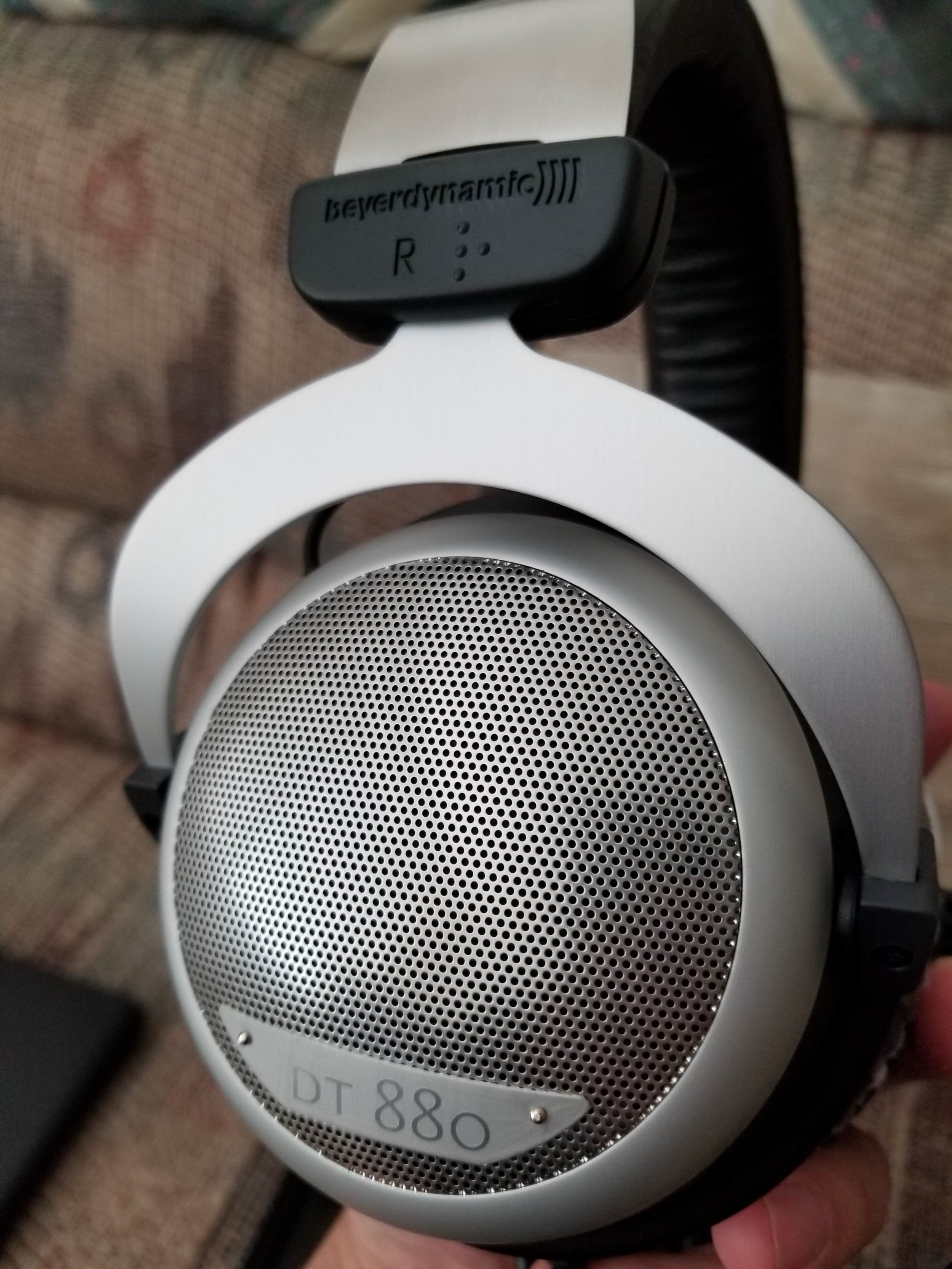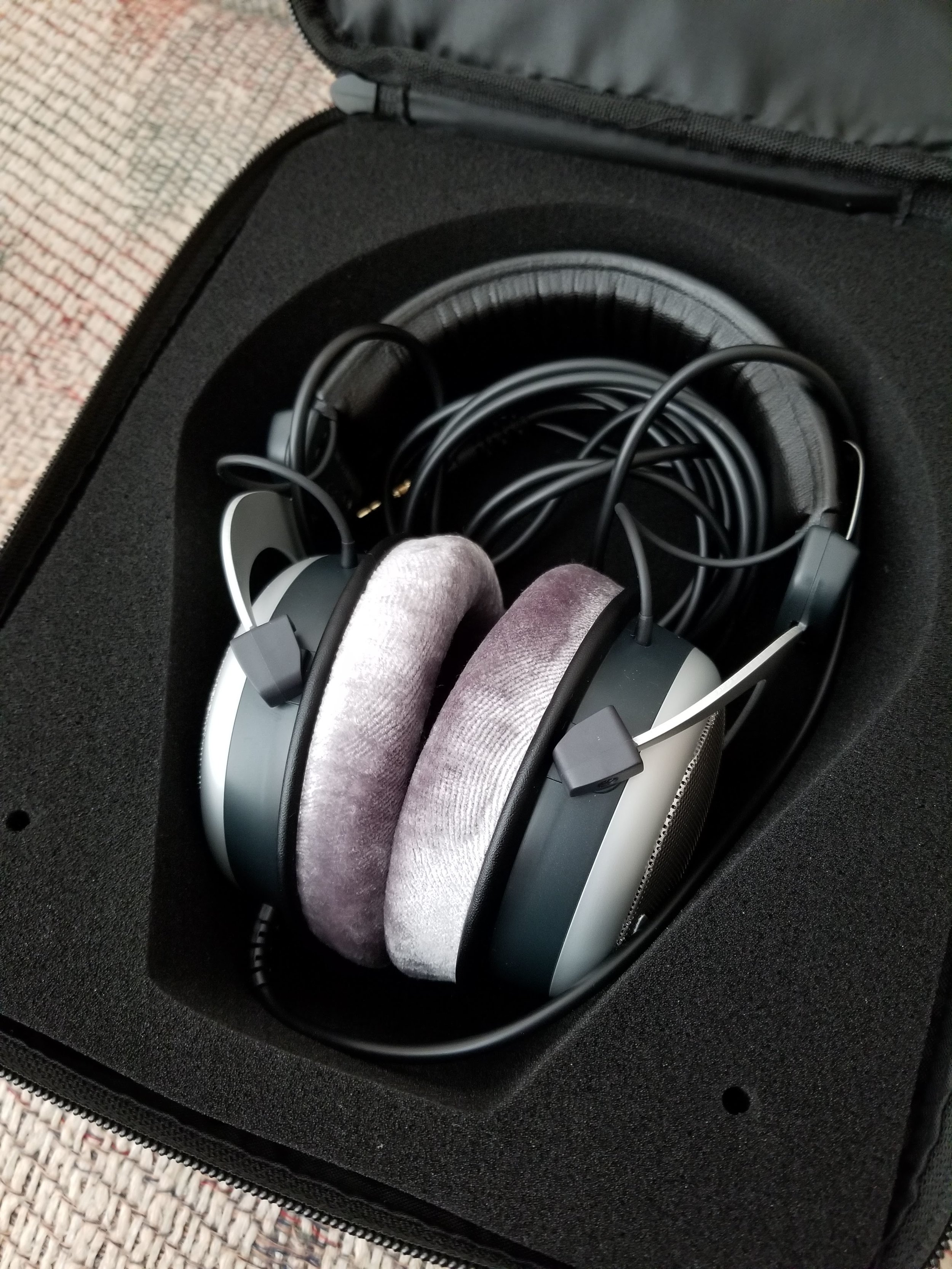Beyerdynamic DT 880 Edition 600 Ohm Review
In my Sennheiser HD 58X review, I said I didn't know of any equal or better-sounding headphones you could get in the $150 range.
Beyerdynamic's DT 880 normally goes for around $200, but I managed to get one on sale for $141 on Amazon...so now I have to eat those words from the last review a little bit.
OVERVIEW
Beyerdynamic's DT 880 is a "semi-open," neutrally-tuned headphone that's the most popular model in the 770/880/990 range for audiophile listeners and professional audio work.
It comes in multiple flavors and impedance ratings.
The Pro model has a coiled cable and a 250 ohm impedance. It uses the same strong-clamping headband and padding from the 770 and 990 Pro, and has a basic silk-screened logo on the side of the cups.
The Edition model, sometimes also confusingly referred to online as the Premium model depending on where you're looking, comes in a whole huge variety of flavors. They all share a looser clamp in common, and have cosmetics designed to appeal to a home listener instead of a production studio.
You can get the 880 Edition in 32, 250, or 600 ohm impedance models, and they all have a 10-foot straight cable. In addition to the standard look, there's a special chrome edition with black ear cups and the headband padding from some of Beyer's more expensive home models like the T1.
The Edition has a much softer clamping force than the Pro model, and a slightly less-padded headband. The headband pad is still replaceable, though instead of using the snaps of the Pro version it uses a weird ziploc-bag-style fastener.
Also, the Edition versions come with a nice carrying bag...or a hard case if you go for the chrome version.
Normally, the retail prices of these models all hover in the $200-$220 range. When this model first launched a couple of decades ago, it sold for $499.
WILL I NEED AN AMP FOR THIS HEADPHONE?
Yes! Yes you will.
This is one of the only models I've reviewed where I can say, definitively, that you'll want a dedicated amp. The headphones sounded great out of both a Soundblaster X G5 and a Schiit Fulla.
It's true that motherboard audio is better these days, and depending on the hardware you're rocking, you'll still get decent audio quality.
But those motherboard outputs are designed for consumer headphones, which usually run between 32 and 150 ohms. And have high sensitivity ratings.
The DT880 I bought, in addition to having a high impedance rating that will place its own demands on the amp, has a sensitivity of just 96dB per milliwatt. That's on the low side of things.
I always test every pair I review in a wide variety of listening conditions. In addition to powering the 880's with a few amps, I plugged them into my Dell G5 laptop. The G5 has a totally capable headphone amp, and its handled everything else I've thrown at it quite well.
With the 880's, I got a totally acceptable audio quality, and control of the driver was just fine.
However.
I had to turn my windows volume up to 80 before I got what I found to be a pleasant volume. And I could totally stand it cranked to 100. I'm not a fan of listening at loud volumes. So the fact that I could listen at 100 says a lot.
You will absolutely benefit from having a dedicated amp, if you go for the 600 ohm version of these. Their sound is also detailed enough to allow you to suss out the tiny differences between different amp and DAC setups.
If you want to give these a shot but don't want to buy an amp, consider buying the 32 ohm or 250 ohm versions. They're tuned to have a very similar sound signature, and from what I've read online, the differences in driver speed are minor enough that only the most picky would notice them.
SOUND QUALITY
I'm a big fan of the other headphones in this Beyerdynamic family, and the 880 has the most refined sound presentation out of the three.
That's kind of amazing!
Both the 770 and the 990 have slightly v-shaped signatures, with aggression present in both the bass and highs.
The 880 still retains a little dollop of the knife-to-the-ears Beyerdynamic treble, but the rest of the range is comically smooth and neutral.
Bass is impressively well-extended for an open headphone. I can hear every low bass tone just fine, although they're not at all overwhelming, thumpy, or accentuated in any way. You'll get precisely what's in the original mix and not a single hint more. If you've been listening to a bass heavy headphone or a typical closed-back, and then switch to the 880, it'll sound stark and lean at first listen. But after a little adjustment, the bass is fully there and accounted for, something only the best open back designs manage.
Mids are breathtakingly natural and airy, with a "hyper-detailed" and open sound to them. This is thanks to some peaks in the upper mid and treble ranges, aka the infamous "Beyerdynamic Treble."
In my review of the 990, I said that it was sometimes like getting stabbed with treble. I know i keep bringing up this comparison but it's the easiest way to articulate what Beyer treble is like if you've never heard it. It's like the headphones sometimes get mad and just attack you with a bit of treble.
It's not nearly as aggressive in the DT 880's, thank goodness, with only rare treble rage moments depending on what you're listening to.
The overall even response here is right in line quality-wise with the HD 58X's I just listened to, though with more air/detail and a wider soundstage. In fact, the soundstage, depth, and imaging are among the best I've ever heard in a pair of headphones.
The impressively flat response, combined with the hiss-revealing detailed treble, means these would be a phenomenal audio mixing headphone.
As a fun home listening headphone, they're less successful. The bass is probably not punchy enough for the average consumer, and if you're a loud-volume listener the treble response might get to you after a while.
However, if you're into video games and you want an expansive soundstage and good footstep awareness, and don't mind a slight lack of head rumble...this is an excellent choice.
COMFORT
If I gave out scores in these reviews, the DT 880 would get all of the points in comfort. In spite of having round ear cups, they're quite spacious and deep, and they're softly padded on the inside in case your ear runs into things.
These use the same exact ear pads as the DT990. They have an ultra soft velour fabric over a squishy foam that's less dense than the foam used on the 770's, since they don't need to isolate you from the outside. The pads are more durable than the pads on the 58X, and they aren't bothered at all by my thin-armed glasses.
Adjustment range is quite large. Even with my larger head, I have a few extra clicks.
The clamp is loose enough for these to just gently hug your head, which is a little alarming at first coming from clampier headphones. They essentially disappear while you're wearing them, and they don't shift around too much during aggressive head-shaking. You know, for those times when you're randomly shifting your head around while listening to audio.
ISOLATION
Don't be fooled by Beyerdynamic's use of the phrase "semi-open." The DT 880 is basically an open-backed headphone. Sure, it has a tighter grill and some damping material behind the driver, but as far as isolation and leak performance goes, there's almost zero difference from a fully open headphone. They might isolate more than other open headphones I own by like, 2 dB.
These are best suited for use in a quiet indoor environment.
BUILD/DESIGN
Like every other headphone in this range, the DT880 has a tank-like pro-studio-style build with fully user-replaceable parts. They're hand-made in Germany out of a mix of metal and plastic.
The ear pads and headband pad are easily replaceable, which is great! The cable is permanently attached, which is not so great especially for a headphone of this price in 2018... but you could add your own removable one if you're comfy soldering.
I normally give headphones endless crap for doing this, but I actually really like Beyerdynamic's cables. They're a great balance between pliable and strong. Unlike the cable on the Sennheiser Game One.
At the end of the cable there's a big sturdy plug with a 3.5mm connector, and Beyerdynamic includes a screw-on unimatch 6.3mm adapter in the box.
The headband, forks, and ear cups use the same basic design language as the 770 and 990, although the outsides of the cups are covered with a metal mesh grill. At first glance, this grill looks like it would be rough and coarse...but it's incredibly smooth to the touch. It's weirdly pleasant to run my fingers along the grill, so smooth is the surface. I was very surprised. It's my second-favorite Beyerdynamic headphone to touch with my hands after the bowling seat plastic on the 770's.
The Edition versions of Beyerdynamic headphones feature weird metal wings on the sides of the headband for no discernible reason. Some people hate these but I think they're weird and okay.
EXTRAS
This is where we talk about the bag. Unlike the delightfully stupid nylon sack included with the Pro models, the Edition model has a nice soft-touch leatherette case with a carrying handle.
The case seems pretty decently-built, though I wouldn't throw it around or sit on it. It has no real rigidity to it, and is designed for storing your headphones when not in use. The inside of the case is a big foam insert with room for the headphones. Unfortunately, the shape of the cutout is a little too standardized, and doesn't include a whole lot of room for the strain relief of the cable. So you'll have to get a little creative with how you place the headphones and cord inside. It all still fits, but it would be cool if they had a second cutout for the cable to live in.
WHO SHOULD BUY THIS?
These are best suited to audio professionals, critical listeners that want to hear every detail and flaw in their original recordings, and gamers who don't mind a slightly less-aggressive bass. Their transparency and their soundstage are their best assets, although you have to be willing to enjoy a little zip in the treble and a muted-though-accurate bass response.
If you're into buying a million amps, the 880 would also be a useful tool for endless nightmare comparisons.
Both the 770 and the 990 are more fun, and both still offer decent soundstage performance.
It's far too late to do this now, but if I were working at Beyerdyamic I'd change the numbering to put the 880 at the top, just to more accurately express its overall neutrality and place in the lineup. It's the "Best-sounding" of the family, but I think the other two models have a bit more fun in their audio that most listeners will find pleasing.
BUT HOW DO THEY COMPARE TO THE 58X?
As I alluded to above, switching between these two models was quite revealing of their differences. The 58X feels a touch dark in comparison, with much more fun in its sub and mid-bass response. The 58X has a timbre that's more smooth and inviting, and they're probably a better overall choice for long-session fun listening.
But as someone who personally loves Beyer's weird treble obsession for reasons I can't fully articulate other than saying its personal preference, the resolution and soundstage of the 880 are both much better to my ears. Where the 58X is like sitting in a room with wonderfully tuned speakers, the 880 feels like the raw audio data is being pumped into the space around your head.
The general build of the 880 is better, and the lighter clamping force will be much more comfy for most people out of the box.
For my tastes, the 880 is the better overall headphone. The 58X has a more natural, pleasing sound and a removable cable, but I like everything else about the 880 just a touch more.
Both have their uses and both are at the absolute upper bound of sound quality for headphones in this price range. Each is a safe buy if you're looking at raw value, so it's down to your personal tastes.
FINAL THOUGHTS
The Beyerdynamic DT 880 Edition is a phenomenal-sounding headphone, with a hilariously flat response accentuated by some airy treble and a brilliantly wide soundstage. I love the sound, but those of you who are way into bass or want a more relaxing listen might not. Just like Sennheiser's 600 series, I fully understand why these have stood the test of time. It's apparent from just a few minutes of listening, and I've loved using these exclusively for the last week.
In spite of using the same core driver, the 770, 880, and 990 all have very different sound profiles, with the sharply detailed treble being the one core similarity outside the visual design.
The 880 easily has the "Best" sonic performance of the family, as long as "Best" means "closest to the source audio" in your mind. It was instantly apparent to me why these have retained their popularity for so long, and they're going to proudly live on my shelf right next to the HD 58X for a very long time.
I might still hate Beyerdynamic's marketing strategies, but man do they make good headphones! I could only stay away for so long.











